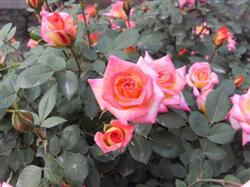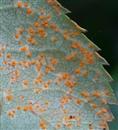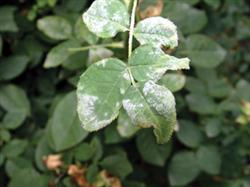Rose lobular disease

Symptomatic rose lobular disease is a common physiological disease in northern China. Lobular disease occurs on young shoots and young leaves, and the disease is more obvious when the spring rose sprouts. The diseased branches germinated later, the leaves were narrow and slender, the leaf edges were upward, the quality was hard and brittle, the leaf color was light yellowish green, and the leaf color was uneven. The tip of the new shoot was slender, the internodes of branches were short, the fine leaves were rosette, and the growth of diseased branches was weak. Most of the disease is caused by the whole plant. Rose lobular disease is a physiological disease caused by zinc deficiency, which is an essential element in the synthesis of auxin. Free and bound auxin decreased significantly during zinc deficiency, resulting in growth stagnation. Zinc deficiency is easy to occur when there is little zinc in soil and other trace elements are not balanced. Zinc deficiency occurs when the zinc content in leaves is less than 10 to 15ppm. ① control method according to the local soil fertility, appropriate application of organic fertilizer and trace elements to improve the soil, which is the basis for the prevention and control of rose lobular disease. ② combined with base fertilizer in spring and autumn and mixed application of zinc sulfate to control. In the rose garden with zinc deficiency caused by magnesium deficiency or copper deficiency, compound fertilizer containing magnesium and copper should be applied at the same time in order to achieve obvious control effect. In early spring, ③ sprayed branches with 0.3% to 0.5% zinc sulfate once or twice a year when the buds began to germinate; before flowering, spraying 300mg / kg zinc naphthenate and spraying 0. 2% zinc sulfate plus 0.3% urea or 300mg / kg zinc naphthenate or 300x zinc amino acid solution had obvious effect on reducing the disease.
- Prev

Symptoms and control methods of rose rust
Rose rust occurs in countries with suitable climate all over the world. It sometimes causes serious harm to rose cultivated in greenhouse. In addition to rose, the disease can also infect roses, roses and other flowers. There are many kinds of pathogens of rose rust, including 10 species reported abroad and 3 species known in China. One of them is short point.
- Next

Why did the rose cuttings die?
Symptoms: mainly harmful to flowers, leaves and twigs. At the beginning, the petals appear watery spots or petal tips, the edges become brown, rapidly expand, wilt, rot, and finally the whole flower browns and wilts. Under wet conditions, gray-green mildew can be seen, that is, conidiophores and conidia of pathogens. The characteristics of the disease.
Related
- Fuxing push coffee new agricultural production and marketing class: lack of small-scale processing plants
- Jujube rice field leisure farm deep ploughing Yilan for five years to create a space for organic food and play
- Nongyu Farm-A trial of organic papaya for brave women with advanced technology
- Four points for attention in the prevention and control of diseases and insect pests of edible fungi
- How to add nutrient solution to Edible Fungi
- Is there any good way to control edible fungus mites?
- Open Inoculation Technology of Edible Fungi
- Is there any clever way to use fertilizer for edible fungus in winter?
- What agents are used to kill the pathogens of edible fungi in the mushroom shed?
- Rapid drying of Edible Fungi

